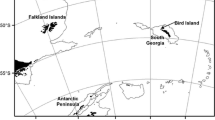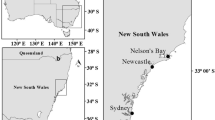Abstract
Regurgitations were collected from 41 black-browed albatross adults feeding chicks at Bird Island (54°S 38°W), South Georgia in February 1986. The samples were sorted into recognisable food categories and weighed. Cephalopods were identified by means of the lower beak, or in some cases the gladius, and allometric equations were used to calculate mantle length and wet body weight represented by beaks. The samples contained 35.5%Euphausia superba, 30.9% cephalopods and 27.1% fish, by weight. A total of 21 samples contained recognisable cephalopod remains and 20 contained specimens that could be identified. In all, 50 cephalopod specimens, representing an estimated 6,866 g wet weight, were identified. The diet was dominated in terms of numbers, weight and percent occurrence by the ommastrephid squidMartialia hyadesi, and in most cases the entire squid was present with only partial digestion of the skin and arm armature. The cranchiid squidGaliteuthis glacialis was the only other cephalopod of numerical importance but no soft parts were present suggesting that, although significant in the diet of the adults, this species was not being fed to chicks. One specimen each ofGonatus antarcticus, Chiroteuthis sp.,Histioteuthis sp. B. and the octopodidPareledone polymorpha were also present. The cephalopod composition of the diet corresponded closely with a collection made 10 years earlier. The commonest species in the bird's diet,M. hyadesi, has not been found in net and jig samples at South Georgia although it has been taken from the Antarctic Polar Frontal Zone to the west of the Island. The presence of almost complete, undigested, specimens ofM. hyadesi in the bird's diet indicates that it occurs relatively close to South Georgia.M. hyadesi preys largely on myctophid fishes, which themselves prey on small zooplankters, so a significant component of the black-browed albatross diet depends on a food chain which largely by-passesE. superba.
Similar content being viewed by others
References
Clarke MR (1986) A handbook for the identification of cephalopod beaks. Clarendon Press, Oxford, p 273
Clarke MR, Prince PA (1981) Cephalopod remains in the regurgitations of black-browed and grey-headed albatrosses at South Georgia. Br Antarct Surv Bull 54:1–7
Clarke MR, Croxall JP, Prince PA (1981) Cephalopod remains in the regurgitations of the wandering albatrossDiomedea exulans L. at South Georgia. Br Antarct Surv Bull 54:9–21
Croxall JP, Rickets C, Prince PA (1984) Impact of seabirds on marine resources, especially krill of South Georgia waters. In: Causey Whittow G and Rahn H (eds) Seabird energetics. Plenum Publishing Corporation, New York, pp 285–317
Everson I (1984) Fish biology In: R.M. Laws (ed) Antarctic ecology Volume 2. Academic Press, London, pp 491–532
Kock K-H (1992) Antarctic fish and fisheries. Cambridge University Press, Cambridge, pp 359
Lipinski MR, Jackson S (1989) Surface-feeding on cephalopods by procellariiform seabirds in the southern Benguela region, South Africa. J Zool Lond 218:549–563
Prince PA (1980) The food and feeding ecology of grey-headed albatrossDiomedea chrysostoma and black-browed albatrossD. melanophrys. Ibis 122:476–488
Rodhouse PG (1989) Pelagic cephalopods caught by nets during the Antarctic research cruises of the ‘Polarstern’ and ‘Walther Herwig’, 1984–87. Arch Fisch Wiss 39:111–121
Rodhouse PG (1990) Cephalopod fauna of the Scotia Sea at South Georgia: potential for commercial exploitation and possible consequences. In: Kerry K, Hempel G (eds) Antarctic ecosystems. Ecological change and the conservation. Springer, Berlin Heidelberg New York, pp 289–298
Rodhouse PG (1991) Population structure ofMartialia hyadesi (Cephalopoda: Ommastrephidae) at the Antarctic Polar Front and the Patagonian shelf, South Atlantic. Bull Mar Sci 49:404–418
Rodhouse PG, Yeatman J (1990) Redescription ofMartialia hyadesi Rochebrune and Mabille, 1889 (Mollusca: Cephalopoda) from the Southern Ocean. Bull Br Mus nat Hist (Zool) 56:135–143
Rodhouse PG, Clarke MR, Murray AWA (1987) Cephalopod prey of the Wandering AlbatrossDiomedea exulans. Mar Biol 96:1–10
Rodhouse PG, Prince PA, Clarke MR, Murray AWA (1990) Cephalopod prey of the grey-headed albatrossDiomedea chrysostoma. Mar Biol 104:353–362
Rodhouse PG, Arnbom TR, Fedak MA, Yeatman J, Murray AWA (1992a) Cephalopod prey of the southern elephant seal,Mirounga leonina L. Can J Zool 70:1007–1015
Rodhouse PG, White MG, Jones MRR (1992b) Trophic relations of the cephalopodMartialia hyadesi (Teuthoidea: Ommastrephidae) at the Antarctic Polar Front, Scotia Sea. Mar Biol 114:415–421
Rodhouse PG, Croxall JP, Prince PA (1993) Towards an assessment of the stock of the ommastrephid squidMartialia hyadesi in the Scotia Sea: data from predators. Okutani T O'Dor RK, Kubodera T (eds) Recent Advances in Cephalopod Fishery Biology Tokai University Press, Tokyo (in press)
Author information
Authors and Affiliations
Rights and permissions
About this article
Cite this article
Rodhouse, P.G., Prince, P.A. Cephalopod prey of the black-browed albatrossDiomedea melanophrys at South Georgia. Polar Biol 13, 373–376 (1993). https://doi.org/10.1007/BF01681978
Received:
Accepted:
Issue Date:
DOI: https://doi.org/10.1007/BF01681978




